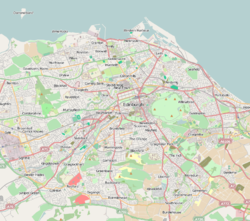History
The building was designed by Thomas Duncan Rhind in the free Renaissance style as the headquarters of the 9th (Highlanders) Battalion the Royal Scots and completed in 1912. [1] The battalion was mobilised at the drill hall in August 1914 before being deployed to Western Front. [2]
The battalion amalgamated with the 7th Battalion to become the 7th/9th (Highlanders) Battalion, The Royal Scots, with its headquarters at the Dalmeny Street drill hall but with elements at the East Claremont Street drill hall, in 1922. [3] The 7th/9th Battalion and the 8th Battalion amalgamated to form the 8th/9th Battalion, still at the Dalmeny Street drill hall but with representation at the East Claremont Street drill hall, in 1961. [3] The 8th/9th Battalion was reduced to company size as A (Royal Scots) Company, the 52nd Lowland Volunteers in 1967 and this unit in turn evolved to become HQ (Royal Scots) Company, Lowland Volunteers in 1995. [4]
After the Dalmeny Street drill hall was decommissioned in the late 1990s, this unit, in its new designation as A (Royal Scots) Company, 52nd Lowland Regiment, became based at the East Claremont Street drill hall in 1999. [4] This unit evolved further to become A (Royal Scots Borderers) Company, 52nd Lowland, 6th Battalion The Royal Regiment of Scotland, still based at the East Claremont Street drill hall, in 2006. [4] The building, which is known as Hepburn House after Sir John Hepburn, founder of the Royal Scots, remains an active Army Reserve Centre. [5]
This page is based on this
Wikipedia article Text is available under the
CC BY-SA 4.0 license; additional terms may apply.
Images, videos and audio are available under their respective licenses.

